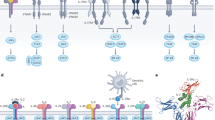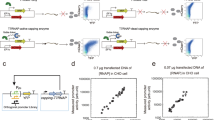Abstract
DNA shuffling of a family of over 20 human interferon-α (Hu-IFN-α) genes was used to derive variants with increased antiviral and antiproliferation activities in murine cells. A clone with 135,000-fold improved specific activity over Hu-IFN-α2a was obtained in the first cycle of shuffling. After a second cycle of selective shuffling, the most active clone was improved 285,000-fold relative to Hu-IFN-α2a and 185-fold relative to Hu-IFN-α1. Remarkably, the three most active clones were more active than the native murine IFN-αs. These chimeras are derived from up to five parental genes but contained no random point mutations. These results demonstrate that diverse cytokine gene families can be used as starting material to rapidly evolve cytokines that are more active, or have superior selectivity profiles, than native cytokine genes.
This is a preview of subscription content, access via your institution
Access options
Subscribe to this journal
Receive 12 print issues and online access
$209.00 per year
only $17.42 per issue
Buy this article
- Purchase on Springer Link
- Instant access to full article PDF
Prices may be subject to local taxes which are calculated during checkout




Similar content being viewed by others
References
Sprang, S.R. & Bazan, J.F. Cytokine structural taxonomy and mechanisms of receptor engagement. Curr. Opin. Struct. Biol. 3, 815–827 (1993).
Dusheiko, G. Side effects of alpha interferon in chronic hepatitis C. Hepatology 26, 112S–121S (1997).
Vial, T. & Descotes, J. Clinical toxicity of the interferons. Drug Experience 10, 115–150 (1994).
Funke, I. et al. Capillary leak syndrome associated with elevated IL-2 serum levels after allogeneic bone marrow transplantation. Ann. Hematol. 68, 49–52 (1994).
Schomburg, A., Kirchner, H. & Atzpodien, J. Renal, metabolic and hemodynamic side-effects of interleukin-2 and /or interferon alpha: evidence of a risk /benefit advantange of subcutaneous thereapy. J. Cancer Res. Clin. Oncol. 119, 745–755 (1993).
Henco, K. et al. Structural relationship of human interferon alpha genes and pseudogenes. J. Mol. Biol. 185, 227–260 (1985).
Horisberger, M.A. & Di Marco, S. Interferon-alpha hybrids. Pharmacol. Ther. 66, 507–534 (1995).
Blatt, L.M., Davis, J.M., Klein, S.B. & Taylor, M.W. The biologic activity and molecular characterization of a novel synthetic interferon-alpha species, consensus interferon. J. Interferon Cytokine Res. 16, 489–499 (1996).
Stemmer, W.P.C. Searching sequence space. Biotechnology 13, 549–555 (1995).
Patten, P.A., Howard, R.H. & Stemmer, W.P.C. Applications of DNA shuffling to pharmaceuticals and vaccines. Curr. Opin. Biotechnol. 8, 724–733 (1996).
Crameri, A., Raillard, S.A., Bermudez, E. & Stemme, R.W.P. DNA shuffling of a family of genes from diverse species accelerates directed evolution. Nature 15, 288–291 (1998).
Uze, G., Lutfalla, G. & Mogensen, K.E. Alpha and beta interferons and their receptor and their friends and relations. J. Interferon Cytokine Res. 15, 3–26 (1995).
Burbank, L. in Luther Burbank, his methods and discoveries: their practical application Vol. 1 (eds Whitson, J. & Williams, R.J.H.S.) 176–210 (Luther Burbank Press, New York; 1914).
Haldane, J.B.S. A mathmatical theory of natural and artificial selection Cambridge Phil. Soc. Trans. 23, 19–41 (1924).
Muller, H.J. The relation of recombination to mutational advance. Mutat. Res. 1, 2–9 (1964).
Moore, J.C., Jin, H. & Arnold, F.H. Strategies for the in vitro evolution of protein function: enzyme evolution by random recombination of improved sequences. J. Mol. Biol. 272, 336–347 (1997).
Tymms, M.J., McInnes, B., Alin, P., Linnane, A.W. & Cheetham, B.F. Structure-function studies of interferon-alpha based on random mutagenesis and expression in vitro. Genet. Anal. Techn. Appl. 7, 53–63 (1990).
van der Meide, P.H. & Schellekens, H. Anti-cytokine autoantibodies: epiphenomenon or critical modulators of cytokine action. Biotherapy 10, 39–48 (1997).
Konrad, M. Immunogenicity of proteins administered to humans for therapeutic purposes. Trends Biotechnol. 7, 175–179 (1989).
Allegreta, M. et al. The development of anti-interleukin-2 antibodies in patients treated with recombinant human interleukin-2 (IL-2). J. Clin. Immunol. 6, 481–490 (1986).
Lynch, M. & Wallace, B. in Genetics and analysis of quantitative traits (Sinauer Associates, Sunderland, MA; 1998).
Fuh, G. et al. Rational design of potent antagonists to the human growth hormone receptor. Science 256, 1677–1680 (1992).
Lowman, H.B. & Wells, J.A. Affinity maturation of human growth hormone by monovalent phage display. J. Mol. Biol. 234, 564–578 (1993).
Thomas, J.W. et al. Potent interleukin 3 receptor agonist with selectively enhanced hematopoietic activity relative to recombinant interleukin 3. Proc. Natl. Acad. Sci. USA 92, 3779–3783 (1995).
Wells, J.A. Additivity of mutational effects in proteins. Biochemistry 29, 8509–8517 (1990).
Weber, H., Valaenzuela, D., Lujber, G., Gubler, M. & Weissmann, C. Single amino acid changes that render human IFN-alpha 2 biologically active on mouse cells. EMBO. J. 6, 591–598 (1987).
Fish, E.N. Definition of receptor binding domains in interferon-alpha. J. Interferon Res. 12, 257–266 (1992).
Uze, G. et al. Domains of interaction between alpha interferon and its receptor components. J. Mol. Biol. 243, 245–257 (1994).
Gutterman, J.U. Cytokine therapeutics: lessons from interferon alpha. Proc. Natl. Acad. Sci. USA. 91, 1198–1205 (1994).
Klaus, W., Gsell, B., Labhardt, A.M., Wipf, B. & Senn, H. The three-dimensional high resolution structure of human interferon alpha-2a determined by heteronuclear NMR spectroscopy in solution. J. Mol. Biol. 274, 661–675 (1997).
Sambrook, J., Fritsch, E.F. & Maniatis, T. in Molecular cloning: a laboratory manual (Cold Spring Harbor Laboratory Press, New York; 1989).
Scarozza, A.M., Collins, T.J. & Evans, S.S. DNA synthesis in nuclei isolated from Daudi B cells: a model to study the antiproliferative mechanisms of interferon alpha. J. Interferon Res. 12, 35–42 (1992).
Acknowledgements
We thank Peter Schultz, Mark Gallop, Eleanor Fish, Russell Howard, Jennifer Jones, Steve Bass, and Volker Heinrichs for critical reading of the manuscript. We thank Malcolm McGregor for assistance with the molecular graphics and Andreas Crameri for sharing unpublished DNA shuffling protocols.
Author information
Authors and Affiliations
Corresponding author
Rights and permissions
About this article
Cite this article
Chang, CC., Chen, T., Cox, B. et al. Evolution of a cytokine using DNA family shuffling. Nat Biotechnol 17, 793–797 (1999). https://doi.org/10.1038/11737
Received:
Accepted:
Issue Date:
DOI: https://doi.org/10.1038/11737
This article is cited by
-
Cytokine Therapeutics in Cancer Immunotherapy: Design and Development
Current Pharmacology Reports (2019)
-
In vitro rapid evolution of fungal immunomodulatory proteins by DNA family shuffling
Applied Microbiology and Biotechnology (2013)
-
Algorithms for optimizing cross-overs in DNA shuffling
BMC Bioinformatics (2012)
-
High efficiency and throughput system in directed evolution in vitro of reporter gene
Applied Microbiology and Biotechnology (2007)
-
Multivalent avimer proteins evolved by exon shuffling of a family of human receptor domains
Nature Biotechnology (2005)



